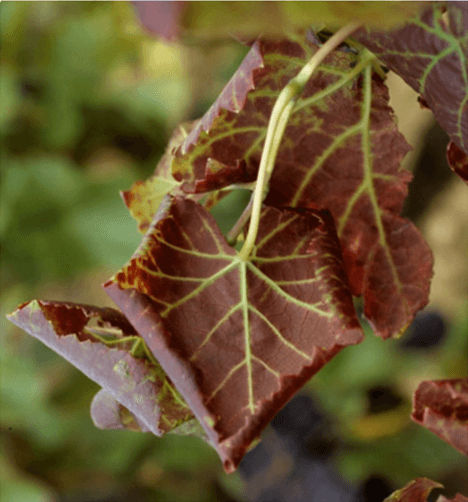What is Grapevine Leafroll Disease?
Grapevine leafroll disease is one of the most widespread and feared viral diseases in viticulture. It is caused by a group of viruses, mainly belonging to the Grapevine leafroll-associated viruses (GLRaV). These viruses progressively attack the vine by disrupting the functioning of the phloem, the tissues responsible for transporting elaborated sap within the plant.
How to recognize the symptoms of grapevine leafroll disease?
Visible signs generally appear from veraison onwards and vary depending on the grape variety:
-
Downward rolling of the leaves, from which the disease takes its name.
-
Red grape varieties (Merlot, Cabernet Sauvignon, etc.): reddening of the leaves while the veins remain green.
-
White grape varieties: yellowing of the leaves.
-
General impact on the vine: reduced vigor, delayed ripening, and lower yields.
-
Impact on grape quality: lower sugar concentration, higher acidity, and an overall reduction in oenological potential.

What are the consequences on the vine and production?
Grapevine leafroll disease can have a significant economic impact on an estate:
-
Long-term yield reduction.
-
Loss of must and wine quality.
-
Premature replacement of vines or entire vineyard blocks.
-
Risk of rapid spread if no adequate control measures are implemented.
How does grapevine leafroll disease spread?
The disease spreads mainly in two ways:
-
Through contaminated plant material: infected scions, vines, or rootstocks.
-
Through insect vectors, particularly mealybugs (Planococcus ficus, Pulvinaria vitis) and pseudococcids, which transmit the virus from one vine to another while feeding on sap.
Preventing and limiting grapevine leafroll disease: which strategies to adopt?
Fighting leafroll is complex, as no curative treatment currently exists. Management therefore relies on prevention and containment of existing outbreaks:
-
Use certified, virus-free plant material.
-
Monitor and control mealybug populations using biological control tools, mating disruption, or, if necessary, targeted treatments.
-
Regularly inspect vineyards to detect early symptoms.
-
Remove infected vines in severe cases to avoid further spread.
-
Implement sanitary fallowing before replanting in case of massive infection.
Towards a more resilient viticulture
In the face of this threat, research is progressing, particularly on the development of early detection tests and more resistant plant material. Vigilance, plant traceability, and close cooperation between nurseries, winegrowers, and diagnostic laboratories are essential to build a more sustainable viticulture.
Summary
| Grapevine Leafroll Disease | Details |
|---|---|
| Causal agents | GLRaV viruses |
| Symptoms | Leaf rolling, reddening or yellowing, loss of vigor |
| Spread | Contaminated plant material, mealybugs |
| Impacts | Yield reduction, grape quality loss, reduced vine lifespan |
| Control | Preventive: clean plant material, monitoring, vector management |
